In core Java book it says
The width of the rectangle that the getStringBounds method returns is the horizontal extent of the string. The height of the rectangle is the sum of ascent, descent, and leading. The rectangle has its origin at the baseline of the string. The top y -coordinate of the rectangle is negative. Thus, you can obtain string width, height, and ascent as follows:
double stringWidth = bounds.getWidth();
double stringHeight = bounds.getHeight();
double ascent = -bounds.getY();
What does the author mean when saying that the rectangle has its origin at the baseline of the string, while top y-coordinate is the ascent?
Where does the bounding rectangle of the string start?
with a test string i got the following:
w: 291.0
h: 91.265625
x:0.0
y:-72.38671875
descent: 15.8203125
leading: 3.0585938
That mean the rectangle origin is at the leading not the baseline, am i correct on this?
